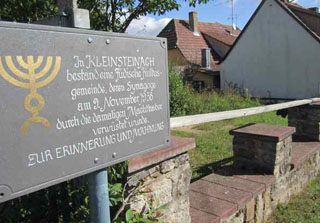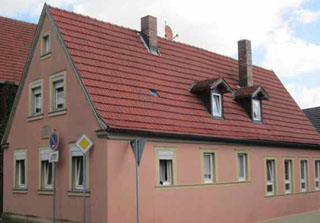Jewish life in Kleinsteinach
Kleinsteinach from 1453 to 1942
Jews are mentioned living in Kleinsteinach as early as 1453. In the 16th century Jews were expelled from the cities and began to settle in villages. They paid protection money to bishops and monasteries or to the nobility in order to stay in the villages. Protection funds were mostly cash payments but also foods such as sugar were offered. By 1699 43 Jewish people lived in Kleinsteinach. In the 17th century Kleinsteinach was the seat of a small Bezirk (District) of rabbis. There were Torah scholars in the community. In1736 a synagogue, was built for the growing Jewish community. By 1814 there were 159 Jews in Kleinsteinach which was 41% of the towns population of 385 residents. The Jewish edict of 1813, contained a number of new rights as well as obligations for the Jews of Bavaria. Jews now could acquire land and participate in trade but they were forced to adopt German surnames and to list the head of the household's name and occupation as shown in the Matrikellisten (census) of 1817. By the second half of the 19th century the Jewish community in Kleinsteinach had a strong econmic life. Jews owned important businesses and shops.There was a textile business with footwear, two livestock operations, two beef butchers, a men's tailor, a matzoh bakery, a fur shop, a shoe shop a grocery store and a property dealer. Due to the large number of small shops Kleinsteinach was called "Little Paris". The Jewish community in Kleinsteinach had a synagogue, a school with a teacher, a ritual bath (mikveh) and a cemetery. However, every head of household, who lived in the village at that time received a number which could only be trasferred to the elder son. This severely limited the opportunity for other males in the family to own a business or property and to marry. This resulted in the emigration of members of the Kleinsteinach community to the United States and other cities. The Jewish population began to decline. Six Jewish soldiers from Kleinsteinach fought during World War 1. One of them, Max Neumann, lost his life. A war memorial was erected for the Jewish victims in the cemetery. After the War anti semitism increased in Germany as international Jewry was blamed for the defeat.
From the book "The Jews of Bavaria" translated by Herb Mautner
In 1933, the community of Kleinsteinach was part of the rabbinical district of Burgpreppach. It included a synagogue, which was built in 1736 and renovated in 1903, a ritual bath, a school, and a cemetery, which was also used by five other communities. The oldest gravestone was dated 1596. Records were kept from 1857 to 1919. Among this pious community, were two groups, which performed good deeds. One was the "Bikkur Cholim Society" who visited the sick, and a religious group which made certain that the evening prayer service was always held after sundown. During the years 1932-1933, only two children received religious training. Starting in 1934, the teacher also taught the children in Aidhausen and Hofheim. The budget of the Jewish community was 2,850 marks in 1930
End of the Jewish Community During the Nazi Era
When Hitler came into power in 1933 only 34 Jews lived in Kleinsteinach. Many Jews suspecting the worse had already fled mostly to the United States and South America. A "Jewish Boycott" made it against the law for a German to buy from a Jew. In 1934 the Jewish cemetery was vandalized. On November 9, 1938, Kristallnacht, members of the SS came into Kleinsteinach. They smashed the windows of Jewish homes, desecrated the synagogue and destroyed the interior. The Jewish men, who had been warned in advance, fled and hid in their Christian neighbor's barns but a hunt began for them. They were attacked as well as the farmers who had helped them. By 1939 there were only 19 Jews left in Kleinsteinach. On April 21, 1940 the last Jewish death was recorded in the village.
-

Synagogue Life
The synagogue was first built in 1736 under the iniative of Rabbi Yechiel Heitz. In 1903 the synagogue was renovated. In 1925 a memorial plaque was placed in the synagogue for the 17 Jewish casualties of World War 1. This plaque along with the torah scrolls and other ritual objects were destroyed on November 9, 1938.
This photograph of the altar is the only photograph that currently exists of the interior of the synagogue. To learn more about the Kleinsteinach synagogue click here.
-

Site of the former Kleinsteinach Synagogue
Today, only about 30 cm of the former foundation of the Kleinsteinach synagogue remain. Otherwise it is just an empty lot. There is a plaque mounted adjacent to the property with the Incription " In Kleinsteinach there was a religious Jewish community, the synagogue was ravaged on November 9, 1938 by the rulers of that time. May this serve to remind and admonish.'
-

The Jewish School
The former Jewish school is now the house of worship for the Evangelical church of Kleinsteinach. There is a plaque that is mounted on the building that reads "Protestant church home - formerly Jewish school - the word of God stands forever."
In the second half of the 19th century Ash Eschwege was a teacher from 1872 to 1879. Nathan Sichel taught in Kleinsteinach from 1879 to 1911. He was followed by Hirsch Wolfrom who taught until 1924. During the years 1932-1933, only two children received religious training. Starting in 1934, the teacher also taught the children in Aidhausen and Hofheim.
